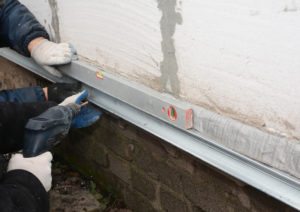Basement Waterproofing: Three Different Strategies
Reliable Basement is now part of ULB-DRY Waterproofing . You are being redirected to similar content on ULB-DRY Waterproofing’s website.
If you are not redirected within 5 seconds, please click here.

Is your basement waterproof? A wet basement can be a real problem, not just because it smells musty and isn’t as functional as it should be, but because moisture in your basement can eventually lead to major issues like structural damage and toxic mold. Here, we’ll take a look at three different strategies for keeping your basement dry.
In order to understand why these strategies are used, you need a rudimentary understanding of why basements become damp in the first place. Sometimes rain and groundwater can’t drain away from the property because of improper soil and drainage systems; it accumulates around the foundation, eventually making its way into the basement. Sometimes this accumulation occurs because the slope around your home is incorrect, and sometimes gutters that are poorly installed and maintained can direct rainwater to the foundation. Hydrostatic pressure can force water through cracks in your basement’s walls and floors, sometimes even causing the cracks, and sometimes the moisture in your basement is simply due to condensation.
- The first approach it waterproofing a basement is to work on the interior. This is usually the easiest and most economical approach. It starts with making sure that any cracks or holes are sealed and watertight, using the special sealant that keeps out water. Using waterproof sealants and other interior waterproofing methods prevents condensation and keeps humidity levels down.
- An exterior approach keeps water from getting inside. It’s a larger undertaking than interior waterproofing, involving excavating soil from around the foundation and putting a waterproof sealant on exterior walls. While someone’s working on your hoe’ exterior, get that person to check your gutters too, to make sure they’re directing water away from the home.
- Attending to drainage is the third approach. If the problem in your basement is poor drainage, a drainage system may be the answer you seek. A sump pump can collect water and pump it away from the house, but it’s better if it doesn’t get there in the first place. It’s also important to check the soil, making sure your home is surrounded by soil that drains quickly and doesn’t retain water. Slope is another issue, so make sure your yard slopes away from your foundation instead of toward it.
A family-owned and operated company, Reliable Basement Services has served the greater Chicagoland area for more than ten years. We offer a full spectrum of basement services, charging reasonable rates for work that includes crack repairs, sump pump systems, basement waterproofing, basement windows, and floor repair. Our consistently high standards have made us an award-winning Chicago basement waterproofing contractor and earned us thousands of satisfied customers all over Chicago. For more information, call (630) 318-4888 or visit our website for a free quote.
